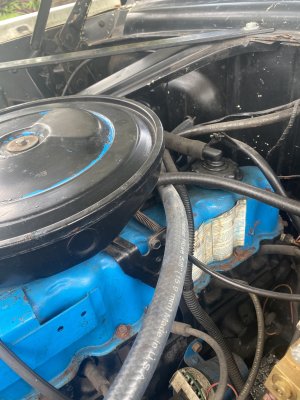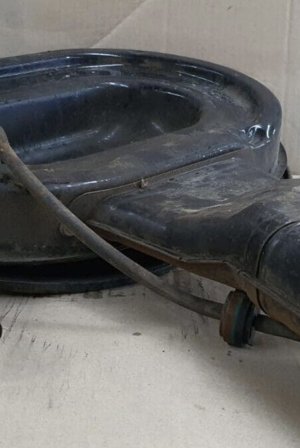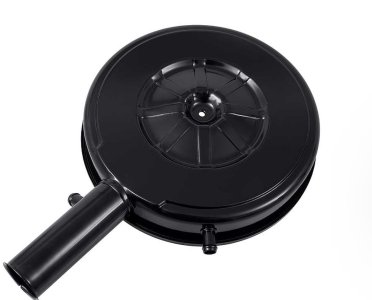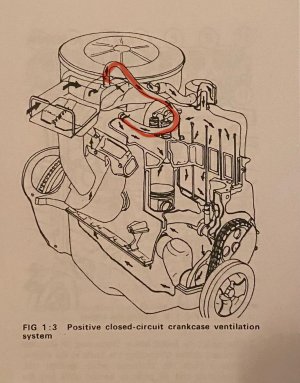My air cleaner housing has a hose going to the oil cap and a little nipple thing inside that I’m not sure about. Does this mean it’s a California emissions model? I’d like to get a new one with the snorkel and have seen some with the hose outlet, but it looks like they have two. Mine only has one, so I’m a little confused where the other one would go. Also, there appears to be a little bit of oil in the cleaner housing, I assume feeding back from the hose. The little sponge at the outlet is a little saturated. Is this hose necessary at all? What if I were to replace the housing without it? The Non -California style..
You are using an out of date browser. It may not display this or other websites correctly.
You should upgrade or use an alternative browser.
You should upgrade or use an alternative browser.
All Small Six 60 Falcon w 200 inline 6 air cleaner housing California?
- Thread starter Richstep14
- Start date
This relates to all small sixes
Not sure about the big oval hole, something was bolted on there, snorkel? The hose going to the oil cap I believe is for the pcv system, the “intake” side. You want clean air being sucked in. You can do away with that hose if you get a vented/ filtered oil cap. Not sure about a second port, I’m sure someone will know 
Awesome thank, I see that and it’s making sense now. The intake hose going to the pcv valve is on a T also going to the power brake booster.
If you don’t have one already, you might want to add a vacuum reservoir to the power brakes. Route it from the tee, through a check valve, to the reservoir, to the booster. I added one to the factory one already in the system, it helped with a more consistent pedal after quick repeated brake applications.
nearGettysburg
Active member
You didn't state what year was the engine.
In 1960, the engine would have been a 144 cid with NO emissions controls. Crankcase ventilation was very simple---air entered the crankcase thru the oil filler cap, a wire maze material filtered the are. The air went to the rocker area where it was warmed and then down into the crankcase and timing chain area and then exited the crankcase thru the road draft tube.
There were no hoses connected to the air cleaner housing. No snorkel to warm the incoming air. The air filter element was exposed on the side towards the firewall.
PVC systems began in 1962--IIRC.
In 1960, the engine would have been a 144 cid with NO emissions controls. Crankcase ventilation was very simple---air entered the crankcase thru the oil filler cap, a wire maze material filtered the are. The air went to the rocker area where it was warmed and then down into the crankcase and timing chain area and then exited the crankcase thru the road draft tube.
There were no hoses connected to the air cleaner housing. No snorkel to warm the incoming air. The air filter element was exposed on the side towards the firewall.
PVC systems began in 1962--IIRC.
I’ve learned a lot of stuff in the past couple of days! Based on the casting codes, the engine is a 1968 200 ci, it does have emissions control.You didn't state what year was the engine.
In 1960, the engine would have been a 144 cid with NO emissions controls. Crankcase ventilation was very simple---air entered the crankcase thru the oil filler cap, a wire maze material filtered the are. The air went to the rocker area where it was warmed and then down into the crankcase and timing chain area and then exited the crankcase thru the road draft tube.
There were no hoses connected to the air cleaner housing. No snorkel to warm the incoming air. The air filter element was exposed on the side towards the firewall.
PVC systems began in 1962--IIRC.
TrickSix
Famous Member
The engine in your car was made in the middle 70s or so. It has a Carter YF carb on it, which has a fairly high mounted choke. See the bulge in the bottom of the air cleaner? That's there to clear that way up there choke. Older air cleaners made for the common 1100 carb won't fit. Yes, the snorkel is missing from the current air cleaner. No big deal, it probably didn't fit or something. But it looks to me like the person who did the engine swap knew what they were doing and did a good job of adapting what was there. I would strongly advise you not to start buying parts before you drive the car some more and get to know it and what's working well and what is not. I believe there's a solid foundation there that may need a little maintenance, but no major changes.
Man, you are right! So I guess the block is 68 and the head is 75-80 from a Grenada or something.The engine in your car was made in the middle 70s or so. It has a Carter YF carb on it, which has a fairly high mounted choke. See the bulge in the bottom of the air cleaner? That's there to clear that way up there choke. Older air cleaners made for the common 1100 carb won't fit. Yes, the snorkel is missing from the current air cleaner. No big deal, it probably didn't fit or something. But it looks to me like the person who did the engine swap knew what they were doing and did a good job of adapting what was there. I would strongly advise you not to start buying parts before you drive the car some more and get to know it and what's working well and what is not. I believe there's a solid foundation there that may need a little maintenance, but no major changes.
Interesting!Actually, the C8DE-B blocks were so good they used them for almost ten years! There wasn't a revision and a number change until a couple D7 and D8 iterations in '77 and '78. I'd bet your whole engine was pulled out of the donor.
No, ratchet on floor automaticYou have a 3 speed column shift trans?
Rich, the deal with the ford casting code, work like this. they are more like design codes not necessarily the year of the part but when the part was designed, so if ford decided not to change it your 76 engine could have a C8=68 or whatever casting code on engine parts.
Last edited:
nearGettysburg
Active member
There should also be a casting date code.
Similar threads
All Small Six
Which Air Cleaner
- Replies
- 3
- Views
- 1K
All Small Six
New Adventures in electrics fans and inline 6’s
- Replies
- 4
- Views
- 262
- Replies
- 4
- Views
- 321
- Replies
- 8
- Views
- 2K






